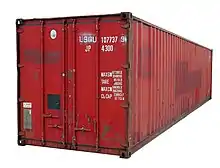Container chassis
A container chassis, also called intermodal chassis or skeletal trailer, is a type of semi-trailer designed to transport shipping containers. It is a wheeled metal frame with twistlocks (pins) onto which a container can be mounted for hauling over roads by a semi-tractor. Container chassis are an important component of intermodal freight transport.
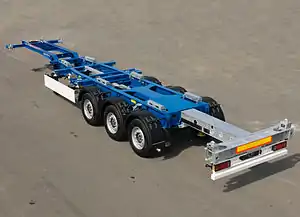
History
The container chassis was invented in the mid-1960's by Keith Tantlinger and his coworkers at Sea-Land and built by Fruehauf Corp.
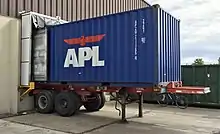
Intermodal
Chassis are used by truckers to transport shipping containers between ports, railyards, container depots, and shipper facilities.[1](p3) This type of trucking is referred to as drayage or intermodal trucking. Drayage is usually the very last or first part of a container's intermodal journey.[1](p2)[2] Intermodal is the use of different transportation modes to deliver cargo. For example, a container loaded with export cargo would be trucked using a container chassis from the shipper's warehouse to the port. Then, the container would be lifted off the chassis, loaded on a container ship, and delivered to an overseas port. Lastly, a trucker at the overseas port would use another chassis to deliver the container to the customer.
Unlike containers, chassis are not transported overseas. They are only used to haul containers within a port or from a port to a shipper and vice versa.
Types
The length of a chassis determines which container length it can accept. The standard ISO containers are either 20-, 40-, or 45-foot-long. For example, a 40-foot-long chassis is used for a 40-foot-long container. While some chassis are fixed length, others can be extended or shortened depending on which container needs to be hauled.[3] The most common adjustable chassis lengths are 40/45.
In some countries there are other lengths of containers used domestically. For example, in North America there are 53-foot-long containers used only within North America. For these 53-foot-long containers, there are 53-foot-long chassis.
Gooseneck chassis
40-foot and longer chassis are sometimes called gooseneck chassis. There is a bend in the chassis frame which is designed to fit into the tunnel at the bottom of containers.
Marine vs domestic chassis
In North America, chassis used for 20-, 40-, and 45-foot long containers are called "marine" or "international" chassis. Domestic chassis are used for 48- and 53-foot containers.
Bomb carts
Bomb carts are used by dockworkers to shuttle containers short distances within a port. Unlike typical container chassis, they have side panels instead of twistlocks, which allows crane operators to quickly place containers on them to hasten the container ship unloading process. Bomb carts are not intended for drayage out of a port.
Tank chassis
- Types of container chassis
.jpg.webp) A truck hauling a bomb cart drives past stacks of containers at Chittagong Port
A truck hauling a bomb cart drives past stacks of containers at Chittagong Port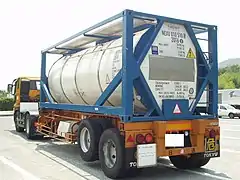 Tank container on a chassis in Japan
Tank container on a chassis in Japan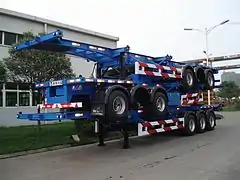 40' gooseneck chassis. Chassis can be stacked to reduce storage space.
40' gooseneck chassis. Chassis can be stacked to reduce storage space.
Operation
A crane is used to place a shipping container on a chassis, ensuring that the container's corner castings line up with the chassis’ pins. The container is then locked to the chassis by engaging the pins.[4] To lift the container off the chassis, the pins are first disengaged. Lifting a container on or off a chassis is referred to as a flip.[5] A semi-tractor can hook up to the chassis to pull it and deliver the shipping container. When not hooked up to a tractor, container chassis have a pair of legs called landing gear which can be lowered to support the chassis. The landing gear are cranked up when the chassis is hooked up to a truck.[6]
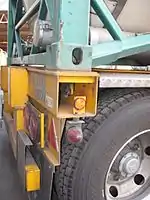
Like any other semi-trailer, chassis have a kingpin which hooks up to the tractor's fifth wheel. Truck drivers also connect the air and electrical lines from their truck to the chassis' gladhand sockets. The air and electricity lines control the emergency brake and lights on the chassis, respectively.
Portable electric generators, also called gensets, can be mounted (underslung) onto chassis. The gensets are used to power a refrigerated container (reefer).[7]
In the US, some chassis, especially 20-foot and 53-foot chassis, have sliding tandems. The tandems are pulled back for heavy containers to comply with federal bridge law weight restrictions.
An identification number is usually stenciled on chassis to keep track of each unit in a fleet. According to ISO 6346, a chassis should have the letter "Z" at the end of its reporting mark. For example, ABCZ-123456 7 would mean the equipment is a chassis, specifically, number 1234567 in the fleet of company ABC.
Marine chassis logistics
United States
In the US, there are two ways container terminals operate. The first is called a "grounded" or "stacked" terminal. At these terminals, containers are stacked on the ground. When drivers need to pick up a box from a grounded terminal, they must bring a bare chassis with them or find one somewhere in the terminal. Unless the driver has a privately-owned chassis, then they need to get a chassis from a chassis pool. Chassis pools are stored at container terminals and are owned by leasing companies. The pool chassis were formerly owned by steamship line and offered to truckers for free, but the steamship lines sold them to the leasing companies in the late 2000s.[8](pp24-26) Once the driver has a bare chassis, they take it to where their container is stacked, and the crane operator lifts the container onto their chassis.
The other type of terminal is called "wheeled"—terminal workers place containers individually on pool chassis and park them before truckers arrive. When truckers arrive, they hook up to the chassis holding their container and drive away. If drivers wish to use a different chassis, they need to pay for a flip.[9][10]
Chassis pools are like car-rental agencies. Whenever a driver out-gates or in-gates a chassis from a terminal, the terminal sends an EDI containing the chassis number, container number (if there is a container), trucking company, and other details to the chassis pool company. The chassis pool company uses this information to invoice the trucking company for daily usage of the chassis. Then, the trucking company passes this cost to their customer.

There are two important caveats in this process. First, the steamship line tells wheeled terminals which chassis pool to use with its boxes. Second, in cases when the steamship line is buying the drayage service (called carrier haulage), the steamship line tells the trucker which chassis pool to use. These caveats are because the steamship lines signed contracts with the chassis pools when they divested from chassis. In these contracts, the steamship line negotiated a rental rate with a particular pool.[8](p26)[11][12] Trucking companies and container terminals have a list of which steamship lines go with which chassis pool. Technically, when picking up a carrier haulage box from grounded terminals, drivers should bring a bare chassis from the steamship line’s chosen pool. Pool chassis are stenciled with the name of pool they belong to, usually a 4-letter code like "COCP".[lower-alpha 1] If the pool is unavailable at the terminal where the box is located, the driver must first bobtail to another terminal to pick up a chassis (called chassis split). Similarly, at wheeled terminals, drivers need to check if the terminal placed the box on the correct chassis pool before they out-gate. In carrier haulage situations, if the trucker does not use the steamship line’s chosen chassis pool, the steamship line will not pay any chassis costs.[13] However, if the shipper/forwarder are buying the drayage service (called merchant haulage), the trucker and shipper can make their own chassis arrangements. Truckers that own private chassis may use them regardless of merchant and carrier haulage. Usually private chassis are used if the box a trucker needs to pick up is on the ground or if there are shortages of pool chassis. However, drivers in-gating a box on a private chassis need to have it lifted off, so they can take the chassis with them when they leave the terminal.
Shortages
In the United States, container chassis shortages are a chronic problem, especially during peaks in freight volume.[15] There are several causes of chassis shortages, but a common problem is excessive off-terminal dwell time. Off-terminal dwell time is the length of time a shipper keeps a chassis/container at their premises. Long dwell times cause shortages at ports and rail ramps where incoming containers need to be loaded onto chassis.[16][17]
See also
References
Footnotes
- This is not the same as the reporting mark, which is also a 4-letter code. The reporting mark ends in "Z" and is always followed by a 6 or 7 digit number. It is used to identify a particular chassis, not the pool.
References
- National Academies of Sciences, Engineering, and Medicine. (2012). Guidebook for Assessing Evolving International Container Chassis Supply Models. Washington, DC: National Academies Press. doi:10.17226/22682. ISBN 978-0-309-25863-0.CS1 maint: multiple names: authors list (link)
- Erera, Alan; Smilowitz, Karen (2008). "Intermodal Drayage Routing and Scheduling". In Ioannou, Petros (ed.). Intelligent Freight Transportation. Boca Raton, FL: CRC Press. p. 172. ISBN 978-0-8493-0770-6.
- Muller, Gerhardt (1989). Intermodal Freight Transportation. Eno Foundation for Transportation. p. 113.
- Hildebrand, Michael; Noll, Gregory; Hand, William (2018). Intermodal Container Emergencies (2nd ed.). Burlington, MA: Jones & Bartlett Learning. p. 69.
- "Intermodal Glossary". Union Pacific. Retrieved December 23, 2020.
Flip: When a container is picked up off of the ground and mounted on a chassis for street or highway transport.
- "Containerisation International Year Book". Containerisation International Year Book. London: National Magazine Company. 1971. Retrieved December 22, 2020.
- Filina-Dawidowicz, L.; Santos, T.; Guedes Soares, C. (2016). "Refrigerated cargo handling: Demand and requirements for Portuguese ports". In Guedes Soares, C.; Santos, T. (eds.). Maritime Technology and Engineering 3. 1. Leiden, The Netherlands: CRC Press. p. 63. ISBN 978-1-138-03222-4.
- U.S. Container Port Congestion & Related International Supply Chain Issues: Causes, Consequences & Challenges (PDF) (Report). Federal Maritime Commission. July 2015. Retrieved December 29, 2020.
- "FAQ On Chassis Provision Choices in CCM Pools" (PDF) (Press release). CCM. Retrieved December 24, 2020.
A container is placed on a chassis at the rail or ocean terminal before the motor carrier arrives for pick up. Unless the container is taken off the chassis and placed on another chassis, the chassis provider is already determined by the ocean container.
- Fact Finding 28: The Memphis Supply Chain Innovation Team. A Single Gray Chassis Pool Fosters Fluid Commerce and Improves Supply Chain Velocity (PDF) (Report). p. 2. Retrieved December 29, 2020.
...the ocean carrier has a conflicting agreement with the railroad that holds the ocean carrier responsible for chassis provisioning regardless of merchant haulage or carrier haulage terms. In essence, the ocean carrier has predetermined usage of chassis provider...
- Mongelluzzo, Bill (June 13, 2019). "Chassis 'utility' model proposed for ports, hubs". JOC.com. Retrieved December 30, 2020.
“Carriers bought the chassis and gave them away for free to attract business,” Rooney said. Then, carriers went almost full circle by renting back the chassis from the equipment providers and offering them at discounted rates, once again to attract business, he said.
- Ashe, Ari (May 30, 2018). "US truckers, shippers frustrated with chassis splits, shortages". JOC.com. Retrieved December 23, 2020.
...'in Memphis, we run a TRAC pool and then we contribute to the CCM pool. If we have assets devoted to the TRAC pool for the steamship line for an agreed upon rate, that’s the asset the motor carrier needs to use'...
- "Hapag-Lloyd Chassis Program – USA Chassis Provider Summary - January Update - Chassis Program Update".
In cases where Hapag-Lloyd is responsible for chassis usage, we will only accept usage from the above providers and pools. If these providers are not used, the trucker will be charged directly, regardless of the terms of chassis provision.
- "Changing U.S. Intermodal Chassis Operations". OCEMA. Retrieved January 8, 2021.
- "Long tail of US chassis shortage snaps shippers". JOC.com. January 22, 2019. Retrieved December 23, 2020.
The container chassis shortage ranks with the truck driver shortage as a perennial issue that returns to disrupt supply chains whenever freight demand surges.
- Ozkan, Utku (October 9, 2020). "WHY THERE IS A CHASSIS SHORTAGE AT THE PORTS OF LOS ANGELES AND LONG BEACH". More Than Shipping. Retrieved December 22, 2020.
- Mongelluzzo, Bill (July 23, 2020). "Chassis equipment issues reemerge at LA–LB port complex". JOC.com. Retrieved December 22, 2020.
Further reading
- O'Brien, Thomas; Reeb, Tyler; Kunitsa, Annette (February 2016). Mitigating Urban Freight Through Effective Management of Truck Chassis (PDF) (Technical report). METRANS Transportation Center.
- National Academies of Sciences, Engineering, and Medicine. (2011). "Chapter 8: Container Chassis Supply Time and Delays". Truck Drayage Productivity Guide. Washington, DC: National Academies Press. doi:10.17226/14536. ISBN 978-0-309-15552-6.CS1 maint: multiple names: authors list (link)
External links
- How truckers can avoid a bad dray day – Six tips for truckers about chassis pools
- At Ag Exporters’ Meeting, the Chassis Debate Rages On – Discussion about the two types of chassis pools, co-op and proprietary
- Georgia, South Carolina seek interoperable chassis pool deal (subscription required) – Summary of how co-op (aka gray) pools work.
- Athearn HO scale chassis – Model Railroading Magazine, June 1999
- RR Rolling Stock Category: Chassis – Picture archives of intermodal chassis in US
